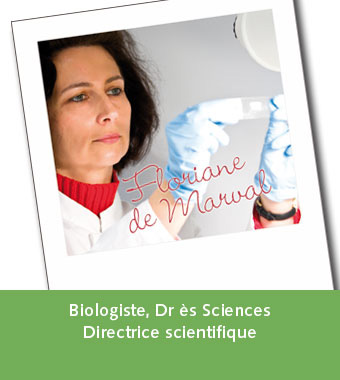Parasitologie, biologie moléculaire / Parasitology, molecular biology
Floriane de Marval

Biologiste, Dr ès Sciences
Directrice scientifique
Parasitologie, biologie moléculaire
Dianalabs - Genève
| Contact | |
|
Dr Floriane de Marval |
 |
Publications
We report the first cases of locally-acquired Diphyllobothrium nihonkaiense (Yamane, Kamo, Bylund and Wikgren, 1986) in Switzerland, confirmed by genetic analysis (18S rRNA, COI and ITS1-5.8S rRNA-ITS2 genes). Diphyllobothriasis in this country is attributed to the tapeworm D. latum (Linnaeus, 1758) but the increasing popularity of raw fish culinary specialities (sushi, carpaccio, tartare) brings out a new diagnostic problem, so that people can get infected by exotic species of tapeworms.
In a study involving 13,842 women and 113 gynaecologists, liquid-based cytology and HPV testing for detecting cervical cancer were compared. A total of 1334 women were found to be positive for one or both tests and were invited for colposcopy with biopsy. A total of 1031 satisfactory biopsies on 1031 women were thereafter collected using a systematic biopsy protocol, which was random in the colposcopically normal-appearing cervix or directed in the abnormal one. In all, 502 women with negative tests were also biopsied. A total of 82 histologic high-grade squamous intraepithelial lesion (HSIL) were reported in biopsies, all from the group with one or both tests positive. Sensitivity and specificity to detect histologic HSIL were 59 and 97% for cytology, and 97 and 92% for HPV. In total, 14% of reviewed negative cytological preparations associated with histologic HSIL contained no morphologically abnormal cells despite a positive HPV test. This suggested a theoretical limit for cytology sensitivity. HPV viral load analysis of the 1143 HPV-positive samples showed a direct relationship between abnormal Pap test frequency and HPV viral load. Thus, not only does the HPV testing have a greater sensitivity than cytology but the probability of the latter being positive can also be defined as a function of the associated HPV viral load.
OBJECTIVE: To evaluate and compare histologic diagnosis of squamous intraepithelial neoplasia and cancer of the cervix with cytologic diagnosis using the conventional Pap smear versus the AutoCyte PREP liquid-based, thin-layer preparation. STUDY DESIGN: Two randomly selected, large patient groups from the same population were studied using two different cervical cytology preparation techniques. Cytologic results were compared to histologic diagnosis to estimate the relative sensitivities and specificities of the preparations. RESULTS: AutoCyte's liquid-based, thin-layer preparation method demonstrated improved agreement with histologic diagnosis as compared to the conventional Pap smear. This result supported the previously reported finding that use of this thin-layer method reduced atypical squamous cells of undetermined significance cases and substantially increased the detection of squamous intraepithelial lesions (SILs). CONCLUSION: Our cytohistologic correlation for conventional Pap smears and the AutoCyte PREP liquid-based preparations demonstrate that the increased rate of both low and high grade SILs on AutoCyte PREP reflects real detection as opposed to overdiagnosis.
OBJECTIVE: The diagnostic performance and clinical value of the combined use of liquid-based Pap test and human papillomavirus testing were determined in 336 patients with a previous abnormal smear. METHOD: Subsequent histologic evaluation was used as definitive diagnosis. RESULT: The combined use of liquid-based Pap test and HPV DNA testing showed higher rates in sensitivity (99.0%), specificity (59.3%), positive predictive value (89.9%) and negative predictive value (94.5%) than either cytology alone (sensitivity 98.8%, specificity 45.7%, positive predictive value 84.7%, negative predictive value 92.6%) or HPV DNA testing alone (sensitivity 84.9%, specificity 67.4%, positive predictive value 88.8%, negative predictive value 59.5%). CONCLUSION: The study demonstrated that the diagnostic accuracy for cervical cancer and its precursors was improved by using the liquid-based Pap test as a primary diagnostic procedure and HPV assay as an adjunctive test. This information may assist the clinicians in triaging patients with equivocal cytologic cervical atypias.
3 patients developed rapid onset of fever and nuchal stiffness. Paresis of brachial muscles occurred within 4 days and all patients had respiratory failure that needed mechanical ventilation. At the peak of the disease there were bilateral asymmetrical severe atrophy of brachial, shoulder and neck muscles, cranial nerve pareses and absent or weak deep reflexes in the upper extremities. CSF analyses showed sterile lymphocytic pleocytosis. In 2 cases the patients suffered a tick bite in Switzerland and the third was probably bitten by an insect while opening a package received from Indonesia. Patients had rapid defervescence and serological tests were found to be highly positive for IgM and then IgG ELISA FSME (Frühsommer-Meningoenzephalitis). The patients were ventilated for 2 to 5 weeks before a progressive improvement was seen. However, on follow-up at 12, 18 and 30 months respectively, proximal muscles were still atrophied and quite weak. Our cases underline that: (1) FSME-ELISA results may cross-react with the Japanese and Central European encephalitis virus species; (2) Flaviviruses do induce unusual and preferential long-term paralysis of the upper extremities simulating poliomyelitis; (3) in the 2 patients studied electrophysiologically, there were signs of axonal reinnervation not seen in lower motor neuron syndrome which were important for reinnervation to permit progressive, but late, motor improvement; (4) there is no evidence of extension of the endemic foci of tick-borne encephalitis in Switzerland.
Morphological and histological analysis of the larval development of Monanema martini, a filaria with skin dwelling microfilariae. The vectors are the hexapod larvae of Rhipicephalus sanguineus, R. turanicus and H. truncatum; the filarial infective stages appear during the larval-nymph moult of the vector (11 days at 26 degrees C). This species, and in our opinion the other species of Monanema, have a complete development in the epidermis of the ticks. Hard-ticks (Ixodidae) appear to be the main vectors of filariae with skin-dwelling microfilariae belonging to Dipetalonema evolutionary line: Yatesia, Cherylia, Cercopithifiliaria, Monanema.
Prise de position / Position paper
Links
- Biology : Free medical journals
- Cancer du col : colposcopie, cytopathologie, histopathologie : Directives
- Cervical cancer: colposcopy, cytopathology, histopathology : Guidelines, reviews, statements, recommendations, standards
- Parasitology : Free medical journals
- Toxoplasmose : Directives
- Toxoplasmosis : Guidelines, reviews, statements, recommendations, standards